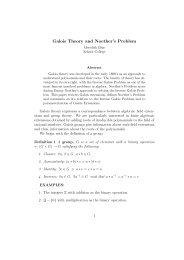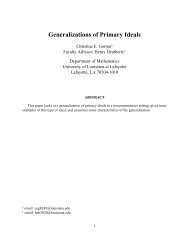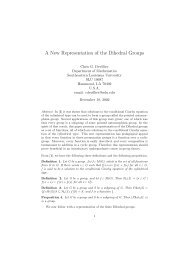Divisibility of the Determinant of a Class of Matrices ... - MAA Sections
Divisibility of the Determinant of a Class of Matrices ... - MAA Sections
Divisibility of the Determinant of a Class of Matrices ... - MAA Sections
You also want an ePaper? Increase the reach of your titles
YUMPU automatically turns print PDFs into web optimized ePapers that Google loves.
<strong>Divisibility</strong> <strong>of</strong> <strong>the</strong> <strong>Determinant</strong> <strong>of</strong> a <strong>Class</strong> <strong>of</strong><br />
<strong>Matrices</strong> with Integer Entries<br />
Sujan Pant ∗ and Dennis I. Merino †<br />
August 28, 2010<br />
Abstract<br />
Let x i = P n<br />
j=1 a ij10 n−j , with i = 1, ..., n, and with each a ij ∈ Z<br />
be given. Let A = [a ij ], and suppose that k ∈ Z is given. If each x i<br />
is divisible by k, <strong>the</strong>n we show that det (A) is also divisible by k.<br />
1 Introduction<br />
The following is proposed as number 1175 in <strong>the</strong> Problem Department <strong>of</strong> [1].<br />
It is known that <strong>the</strong> numbers 14529, 15197, 20541, 38911, and 59619 are<br />
multiples <strong>of</strong> 167. Without actually calculating, prove that <strong>the</strong> determinant<br />
<strong>of</strong> <strong>the</strong> 5-by-5 matrix A is also a multiple <strong>of</strong> 167, where<br />
2<br />
A =<br />
6<br />
4<br />
1 4 5 2 9<br />
1 5 1 9 7<br />
2 0 5 4 1<br />
3 8 9 1 1<br />
5 9 6 1 9<br />
In this problem we are given a 5-by-5 matrix and calculating its determinant<br />
by hand is tedious. We look at a similar problem, but with smaller<br />
∗ Department <strong>of</strong> Ma<strong>the</strong>matics, Sou<strong>the</strong>astern Louisiana University, Hammond, LA 70402<br />
† Faculty Advisor, Department <strong>of</strong> Ma<strong>the</strong>matics, Sou<strong>the</strong>astern Louisiana University,<br />
Hammond, LA 70402-0687; dmerino@selu.edu<br />
3<br />
7<br />
5 .<br />
1
dimension. First, we look at examples involving 2-by-2 matrices to see if this<br />
case holds: if we are given two two-digit integers (say, x = a 1 a 2 and y = b 1 b 2 )<br />
and if <strong>the</strong>se integers are divisible by a given integer k, is it true that k also<br />
<br />
a1 a<br />
divides <strong>the</strong> determinant <strong>of</strong> <strong>the</strong> matrix<br />
2<br />
b 1 b 2<br />
?<br />
<br />
We investigate this case and see if it extends to higher dimensions, that<br />
is to <strong>the</strong> 3-by-3 case, to <strong>the</strong> 4-by-4 case, and in general, to <strong>the</strong> n-by-n case.<br />
Although <strong>the</strong> original problem gave a very specific matrix, we solve a generalization<br />
<strong>of</strong> this problem and also look at o<strong>the</strong>r problems regarding <strong>the</strong><br />
determinant <strong>of</strong> <strong>the</strong> matrix.<br />
We let Z be <strong>the</strong> set <strong>of</strong> all integers, we let N be <strong>the</strong> set <strong>of</strong> all natural<br />
numbers, and we let M n (Z) be <strong>the</strong> set <strong>of</strong> all n-by-n matrix with integer<br />
entries. We also denote <strong>the</strong> determinant <strong>of</strong> a matrix A by det(A).<br />
A two digit natural number ab is really a(10)+b, and a three digit natural<br />
number abc is actually a(10 2 )+b(10 1 )+c(10 0 ). In general, an n digit natural<br />
number a 1 a 2 a 3 a 4 · · · a n actually means<br />
a 1 10 n−1 + a 2 (10 n−2 ) + a 3 (10 n−3 ) + · · · + a n−1 (10 1 ) + a n (10 0 )<br />
where 0 ≤ a i ≤ 9 for each i = 1, 2, ..., n, and a 1 ≠ 0.<br />
Example 1 The numbers 72 and 18 are divisible by 3. The matrix<br />
7 2<br />
1 8<br />
has determinant 7(8) − 2(1) = 54, which is also divisible by 3.<br />
Example 2 The numbers 16 and 36 are divisible by 4. The matrix<br />
1 6<br />
3 6<br />
has determinant 1(6) − 6(3) = −12, which is divisible by 4 as well.<br />
In <strong>the</strong>se examples, we see that if two two-digit positive integers a 1 a 2 and<br />
b 1 b 2 are multiples <strong>of</strong> a positive integer k, <strong>the</strong>n <strong>the</strong> determinant <strong>of</strong> <strong>the</strong> matrix<br />
a1 a<br />
A =<br />
2<br />
(which is a<br />
b 1 b 1 b 2 − a 2 b 1 ), is also divisible by k. Note that even<br />
2<br />
when <strong>the</strong> determinant <strong>of</strong> A is 0, <strong>the</strong>n k also divides <strong>the</strong> determinant <strong>of</strong> A.<br />
2
Proposition 3 Let e,f∈ N be<br />
two digit integers, say e = 10a + b and<br />
a b<br />
f = 10c + d, and let A = . If k is a positive integer that divides both<br />
c d<br />
e and f, <strong>the</strong>n k divides det(A).<br />
Pro<strong>of</strong>. We are given <strong>the</strong> two equations<br />
and<br />
10a + b = e (1)<br />
10c + d = f . (2)<br />
Multiplying equation (1) by −c and equation (2) by a and adding <strong>the</strong>se<br />
equations we get,<br />
ad − bc = af − ce.<br />
Now, e = kr and f = kg, where r and g are integers. Hence, ad − bc =<br />
a(kg) − c(kr) = k(ag − cr), so that k divides (ad − bc).<br />
Therefore, k divides det(A).<br />
Now, we take a look at a particular 3-by-3 example.<br />
Example 4 The numbers 156, 228, and 276 are2<br />
multiples 3<strong>of</strong> 12. A calculation<br />
1 5 6<br />
shows that <strong>the</strong> determinant <strong>of</strong> <strong>the</strong> matrix 4 2 2 8 5 is 36, which is<br />
2 7 6<br />
also a multiple <strong>of</strong> 12.<br />
We now take a closer look at <strong>the</strong> case n = 3. Let<br />
2<br />
a b c<br />
3<br />
A = 4 d e f 5 (3)<br />
g h i<br />
and notice that<br />
det(A) = aei − afh + bfg − bdi + cdh − ceg. (4)<br />
Suppose m, n, and p are three digit integers, say m = 100a + 10b + c,<br />
n = 100d + 10e + f, and p = 100g + 10h + i. Assume that m, n, and p are<br />
divisible by k. We show that k divides det(A).<br />
3
We have following system <strong>of</strong> equations<br />
100a + 10b + c = m (5)<br />
100d + 10e + f = n (6)<br />
100g + 10h + i = p. (7)<br />
If a = d = g = 0, <strong>the</strong>n det (A) = 0, and is divisible by k. Hence, we may<br />
assume that one <strong>of</strong> a, d, or g is nonzero. Without loss <strong>of</strong> generality, suppose<br />
d ≠ 0.<br />
Multiplying (5) by d on both sides, multiplying (6) by −a, and adding<br />
<strong>the</strong>se equations, we get<br />
10 (bd − ea) + cd − fa = md − na (8)<br />
Similarly if multiply (6) by g and if we multiply (7) by −d and adding <strong>the</strong>se<br />
equations, we get<br />
10 (ge − hd) + gf − id = gn − pd (9)<br />
Multiply (8) by − (ge − hd), multiply (9) by (bd − ea) and add <strong>the</strong>se two<br />
equations: (bd − ea) (gf − id) − (cd − fa) (ge − hd) = (bd − ea) (gn − pd) −<br />
(md − na) (ge − hd). Simplifying <strong>the</strong> left hand side, we get<br />
d (aei − afh + bfg − bdi + cdh − ceg) ,<br />
while on <strong>the</strong> right hand side, we have<br />
d(dhm − egm − ahn + bdp − bgn − aep).<br />
Since d ≠ 0, we can divide by d to get<br />
aei−afh+bfg −bdi+cdh−ceg = dhm−egm−ahn+bdp−bgn−aep. (10)<br />
The left hand side <strong>of</strong> this equation is det A. Since m, n, and p are divisible<br />
by k, <strong>the</strong>n each <strong>of</strong> <strong>the</strong> summands on <strong>the</strong> right hand side is divisible by k.<br />
We conclude that k divides detA.<br />
Notice that although our method works, it can get very tedious when <strong>the</strong><br />
size <strong>of</strong> <strong>the</strong> matrix becomes large. This necessitates looking for a different<br />
approach.<br />
4
Before we look at <strong>the</strong> general case <strong>of</strong> this problem we define some important<br />
terminology and facts about matrices.<br />
Let A = [a ij ] be an n-by-n matrix and let M ij denote <strong>the</strong> (n − 1)-by-<br />
(n − 1) matrix obtained from A by deleting <strong>the</strong> row and column containing<br />
a ij . The determinant <strong>of</strong> M ij is called <strong>the</strong> minor <strong>of</strong> a ij . The c<strong>of</strong>actor <strong>of</strong> a ij<br />
[2, pages 102—103] is<br />
A ij = (−1) i+j det(M ij ).<br />
The adjoint <strong>of</strong> a A is<br />
2<br />
3<br />
A 11 A 12 · · · A 1n<br />
A 21 A 22 · · · A 2n<br />
adj (A) = 6<br />
4 . .<br />
..<br />
7 . . 5 .<br />
A n1 A n2 . . . A nn<br />
2<br />
Example 5 Suppose A = 4<br />
3 8 7<br />
2 6 0<br />
5 4 3<br />
3<br />
5.<br />
1. Then A 11 =<br />
6 0<br />
4 3 = 18, A 12 = −<br />
2 0<br />
5 3 = −6,.., and A 33 =<br />
3 8<br />
2 6 = 2,<br />
2<br />
18 −6<br />
3<br />
−22<br />
2. adj(A) = 4 4 −26 28 5, and<br />
−42 14 2<br />
3. det(A) = 3(18) − 8(6) + 7(−22) = −148.<br />
If A = [a ij ] ∈ M n (Z) <strong>the</strong>n adj(A) ∈ M n (Z) because adj(A) is calculated<br />
by adding, subtracting and multiplying <strong>the</strong> entries <strong>of</strong> A. The following is a<br />
connection between a nonsingular matrix and its adjoint [2, page 116].<br />
Lemma 6 Let A be an n-by-n nonsingular matrix with complex entries.<br />
Then A −1 = 1<br />
det(A) adj(A).<br />
Now, we are ready to solve our problem.<br />
5
Theorem 7 Let A = [a ij ] ∈ M n (Z) and fix a nonzero k ∈ Z . Set b =<br />
<br />
b1 · · · b n<br />
T<br />
where bi = a i1 (10 n−1 )+a i2 (10 n−2 )+...+a in (10 0 ). If b 1 , b 2 , .., b n<br />
are all divisible by k, <strong>the</strong>n det(A) is also divisible by k.<br />
Pro<strong>of</strong>. Let A = [a ij ] ∈ M n (Z) be given. First, notice that if A is singular,<br />
<strong>the</strong>n det (A) = 0 is divisible by k. Hence, we may assume that A is<br />
nonsingular.<br />
Suppose A is nonsingular and set z = 10 n−1 · · · 10 0 T<br />
. Then we<br />
have Az = b. We are given that for each i = 1, ..., n, we have b i = kr i for<br />
some r i ∈ Z. Set r = T<br />
r 1 · · · r n . Then b = kr.<br />
Now, A −1 = 1 adj(A). Hence<br />
det(A)<br />
so that<br />
z = A −1 b =<br />
1<br />
det(A) adj(A)b = 1<br />
adj(A)kr (11)<br />
det(A)<br />
det(A)<br />
z = adj(A)r<br />
k<br />
Since adj(A)r ∈ M n (Z), <strong>the</strong>n det(A)<br />
k<br />
∈ Z. Thus, det(A) is divisible by k.<br />
A natural question to ask is: for A ∈ M n (Z), when is A −1 ∈ M n (Z)?<br />
Theorem 8 Let A ∈ M n (Z) be nonsingular. Then A −1 ∈ M n (Z) if and only<br />
if det(A) = ±1.<br />
Pro<strong>of</strong>. Let A ∈ M n (Z) be given. Then det(A) ∈ Z because <strong>the</strong> determinant<br />
is calculated by adding, subtracting and multiplying entries <strong>of</strong> a matrix.<br />
If A −1 ∈ M n (Z), <strong>the</strong>n det(A −1 ) ∈ Z. But det(A −1 ) = 1 . Therefore,<br />
det(A)<br />
1<br />
det(A)<br />
is also an integer. Hence det(A) = ±1.<br />
Conversely, if det(A) = ±1, <strong>the</strong>n A −1 = 1 adj(A) ∈ M det(A) n(Z) since<br />
adj(A) ∈ M n (Z).<br />
References<br />
[1] Problem Department, Pi Mu Epsilon Journal, 12 No.8 (2008) 494-496.<br />
[2] S. J. Leon. Linear Algebra with Applications Sixth Edition. Prentice Hall,<br />
Upper Saddle River, NJ 2002.<br />
6

















